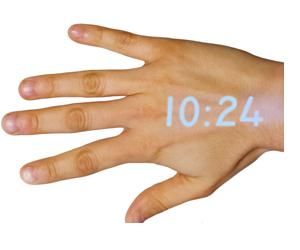Gesture recognition is proving itself as a viable user-interface technique for a variety of equipment. While initially accepted as a way for us to interact with video games, it holds promise as a useful user interface allowing us to control complex tasks. However, it brings with it a new set of challenges for design engineers who must walk a tightrope between size, cost, reliability, power, manufacturability, and functionality.
How it is to be used and implemented is still up for grabs. The evolving Personal Area Network (PAN) may use gesture recognition to predict and respond in real time to a request for information. For example, a chest-mounted camera will be able to see the beginnings of a gesture that presents your backhand to the camera. Your wearable computer can then recognize that you want to know the time, and a pico projector, also chest-mounted, can project the image of a clock on the back of your hand. In a similar fashion, an open hand in front of your chest might conjure a dial pad for the telephone or a menu system that can be used as a touch screen.

Figure 1: Gesture recognition can detect requests for information and make that data available in real time.
As one might imagine, constantly running a high-resolution camera along with a high-end processor that runs algorithms to detect gestures in real time can be processor- and power-consuming. These issues are being addressed with the use of programmable field and resolution control. Once the low-power, low-resolution scanner detects a possible gesture is in progress, frame-by-frame higher resolution edge-enhancement processing can track the gesturing target with greater success. As gesture-recognition applications take off, design engineers must implement every possible technique to simplify processing and reduce the awake time of the devices powering the technology.
One technique that has shown a great deal of promise and benefit is the use of proximity detection as a trigger. As long as gestures are being decoded, a near-body proximity detector can indicate that the user would like to utilize a higher-resolution gesture and wake up the entire system. This technique allows the significantly power-hungry functions to sleep as long as possible.
Another technique to consider is the use of ambient-light sensing, which reduces filtering and processing. As an automatic white-level adjustment of sorts, changing ambient-light sensing can monitor the intensities of primary colors in real time to provide filtering coefficients to the processor engine. This can reduce run time and assure higher-resolution edge detection faster.
For example, Avago Technologies’ APDS-9960 can be used to implement this pre-processing stage. As a digital RGB proximity and gesture sensor device, the small device’s 8-pin package is factory-trimmed and calibrated to 100 mm-proximity detection distances. An integrated UV and IR blocking filter enables accurate ambient-light level sensing and color correlations.
The APDS-9960 uses an embedded IR emitter and four IR detectors for UP-DOWN- RIGHT-LEFT sensing. Micro-optic lenses are integrated into the module along with visible-light-blocking filters for the IR detectors. Operating as an I2C sensor with an interrupt pin, the host processor can work hand-in-hand with the APDS-9960 to reduce some of the memory-intensive and processor-intensive operations, resulting in faster detect and response times.
Advertisement
Learn more about Avago Technologies





